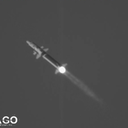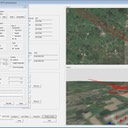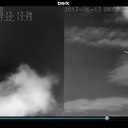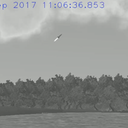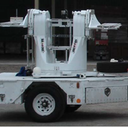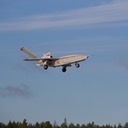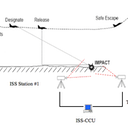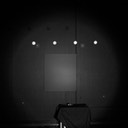IMAGO has completed over 300 contracts and delivered over 40 IMBQ pan/tilts.When you bring an IMAGO tracker to the field, you are also bringing our team's field experience.
1. We have a video target tracker made by another company but it cannot track reliably, what makes your system different?
IMAGO guarantees the performance of our systems. Before IMAGO sells you a system they will ask for the details of the tracking requirement. This allows IMAGO to select the appropriate hardware, tracking algorithms and optics required to ensure that you have the correct equipment to conduct your trials successfully.
Most of our competitors centre their business on selling large numbers of their video tracking boards or pan/tilt subsystems. Most suppliers do not have a standard product that includes both. Sometimes they leave the control system integration to the customer or a third party. Even if they do the integration the tracking and control system are not fully integrated.
In some cases the algorithms embedded on the tracking boards are parameterised and can be set-up from a front panel or downloaded from a computer. However, there is a limit to the amount of parameterisation that can be embedded on a custom hardware board. If the board will not track a given scenario, due to circumstances unforeseen by either the customer or the supplier then a hardware change is needed. These changes are usually impractical. In the rare cases when they can be done, they are time consuming and may leave the customer with a custom jumper set that is not fully supported.
IMAGO sells a complete integrated solution. We have standardised on the pan/tilt we believe is the most cost-effective and have rewritten and optimised its hardware controller in software fully integrated with the video tracking algorithms. As the IMAGO’s Trackers are fully integrated, they have several advantages over separate non-optimised tracking and control subsystems:
More flexibility to meet difficult, unexpected scenarios.
Complete hot spares or loaner trackers are available to help our customers who need another tracker in a hurry.
IMAGO’s business goal is not to mass-produce a large number of hardware tracking boards. We specialise in applications that are too difficult, varied or uncertain to be solved by other trackers.
2. What happens if we buy an IMAGO system and it does not work?
IMAGO guarantees the performance of our systems. Before IMAGO sells you a system they will ask for the details of the tracking requirement. This allows IMAGO to select the appropriate hardware, tracking algorithms and optics required to ensure that you have a successful trial. Once your organization and IMAGO have agreed on the performance requirements IMAGO in conjunction with your organization will write and Acceptance Test Plan (ATP). The IMAGO system must pass the ATP for IMAGO to receive to payment in full. top
3. What is the difference between a video target tracking system and a laser tracking system?
IMAGO offers two different types of technology to measure range. The first approach is to use multiple tracking cameras and triangulation to measure the position of the target. This approach has the benefit of being 100% passive and will work with all types of targets. In addition the target does not need to be augmented (equipped with a reflector) in order to achieve a range measurement. IMAGO has several variants of this technology depending on the accuracy requirements and the cost constraints.
IMAGO’s second approach is to use a single tracking station equipped with a rangefinder (laser or radar). By using the video tracker to point the rangefinder directly at the target IMAGO is always receiving bearing and range information and is not losing data while the scanning system tries to get a return.
IMAGO laser range finder is class 1 eye safe:
Most scanning systems are often not class 1 eye safe because of the high pulse rate
If scanning systems are class 1 eye safe, the range is very limited.
4. Can you track a fast target (Mach 1,2,3,7)?
Yes and no. When using a target tracking system the absolute speed of the target does not affect performance. It is the target’s apparent angular rate that is important. Therefore if a target where infinitely far away from the tracker then the target could be moving infinitely fast. The opposite is also true. I target moving quite slowly that is too close the tracking system will have a high angular rate and the system will not be able to keep.
IMAGO’s standard pan/tilt has a maximum angular rate in excess of 90deg/sec. Assuming that there is a reasonable distance between the target and the tracking station the system should be able to track it. Please provide us with the details of your tracking requirement and we will perform a requirements analysis and let you know what hardware you will require and what the minimum stand off distance should be.
5. What is the image resolution of your system?
IMAGO has just developed a system using 2kx 2k progressive scan cameras. However our standard camera is a 640x480 progressive scan camera. This camera offers a good trade off between image resolution and processing speed.
Our standard camera is progressive scan. This means that the shutter is applied to all pixels at the same time. All pixels are read at the same time, providing a clear image.
6. What is the accuracy of your system?
This is complicated question and the answer depends on the characteristics of your target and test scenario, plus the exact configuration that you select from IMAGO.
Our standard pan/tilt equipped with high performance encoders offer a 20-bit resolution or 0.007 degs. We now offer 26 bit-absolute encoders.
7. What is the frame rate of you system? We need high-speed images?
IMAGO’s standard systems work 60 frame/second. We also have a new system that is capable at tracking at 120fps. If you require faster images then IMAGO recommends that you mount and bore sight a high-speed camera onto the tracking system.
8. GPS is very accurate, why do we need a t tracking system?
Video tracking systems offer a number of advantages. They include:
- The IMAGO system is significantly more accurate
- The IMAGO system has higher data rates.
- No need to attach a recorder onto the aircraft
- IMAGO systems work at all times. Do not have to plan experiments based on position of satellites.
- IMAGO system does not rely on an antenna seeing multiple satellites. Therefore, it is not susceptible to error from the views of satellites changing.
- Target position is available in real time. This can be used to cue other instrumentation.
9. Can we track at night?
Yes as long as the target is equipped with a light or the tracking system is equipped with an infrared imager.
10. Can your system use an IR imager?
Yes, the IMAGO tracking systems will accept most video inputs, including progressive scan, RS-170/NTSC, CCIR/PAL. Most IR imagers output an analogue RS-170 or CCIR image. These images will help to see the target at night, but offer lower resolution that than our standard progressive scan cameras.
11. Can we track in poor weather?
Not usually, as with all video based tracking systems, IMAGO’s trackers must be able to see the target. If the target is not visible it cannot track. If the target is visible and is distinguishable from the background then our system should be able to track them.
12. Does imago have a centroid and or correlation tracker?
Yes IMAGO can offer a centroid or correlation algorithm. However these are names that were applied by Octec. IMAGO has developed a number of more advanced tracking techniques that that work better for backgrounds with any clutter.
Correlation simply means shape and Centroid literally means centre of the target, in Octec’s case it is the centre of the darkest or brightest part of the image.
Hardware trackers are limited in the complexity of their tracking algorithms. The better ones use correlation tracking which works very well for well-resolved targets but does not work well for missile tracking at longer ranges when the missile becomes a point target. Less complex trackers use either some kind of grey scale thresholding (also known as centroid tracking), size filtering or edge detection. Each of these techniques has inherent shortcomings, such as locking onto the ejector motor, smoke or the illumination of the ground. The better trackers allow the operator to switch between these techniques manually but do not switch automatically. During a missile flight the operator often does not have time to change between these tracking techniques.
IMAGO’s business goal is not to mass-produce a large number of hardware tracking boards. We specialise in applications that are more difficult, varied or uncertain to be solved by a rigid hardware architecture.
13. We currently have a complete tracking system but it requires a VME tracker, will your software based tracker work?
Yes it will work. There are several approaches we can uses to integrate with your existing hardware, please contact us to discuss.
14. Why is it that our tracking mount is stated that it can track at 90 deg/sec, but it reaches nowhere near this speed?
Most pan/tilt and tracking manufacturers state maximum angular rates as they relate to the pan/tilt. These rates are what the pan/tilt can respond to when given a command to either move from one position to another or move in a given direction for a given time interval (manual tracking). In close-looped (auto) tracking there are several factors that affect the tracker’s (not the pan/tilt’s) performance. These factors include the size of the field of view, the signal to noise ratio, the time the video tracker takes to process the images and the dynamics of the target. Our trackers process images faster, and use advanced control algorithms to maximize the angular rates in close loop.
IMAGO’s high performance pan/tilt control can track in closed loop at the maximum stated angular rate for most pan/tilts.
15. We would like to get a 3D measurement on a target, we cannot place a reflector on the target and a radar system will not provide enough accuracy.
The IMAGO Trajectory and Miss Distance system measures the 3D position of a target by combining the bearing (azimuth & elevation) from two IMAGO video tracking systems.
16. We have an older tracking system (pan/tilt, cameras, optics), can IMAGO upgrade the system or do we need to buy a whole new system?
Yes, there are several approaches we can use to integrate with your existing hardware, please contact us to discuss.
17. We need to place the tracking system within the cone of fire, how can we install a system safely?
IMAGO has developed a Remote Control system, which provides Remote operation provides the ability to place the pan tilt and cameras up to 20 Km away from the operator. The operator can control the pan tilt, cameras and video tracker and receives back video and tracking data in real time. This allows the operators to be in a common shelter and see each other’s video
18. We are the United States – Army, Navy, Marine Corp, Airforce can you attend our trials?
Yes, IMAGO is Canadian business and most of our employees have NATO secret clearance. In addition we are registered with the Joint Certification Office.
19. Are IMAGO’s systems export controlled?
No. According to the US Department of State our tracking and trajectory products are not subject to the licensing jurisdiction of Department of State. And have been designated EAR 99.
20. How do you support systems that are sold overseas?
IMAGO Machine Vision Inc. is represented by local agents in many countries. Please send us an email and we will put you in contact with the appropriate agent.
21. Does IMAGO offer a color tracking system?
Generally no. Imago uses the monochrome progressive scan cameras rather than colour cameras for the following reasons:
The monochrome progressive scan sensor provides a higher quality image (clearer and less noise) and can detect smaller targets than the colour camera.
The monochrome camera is also higher spatial resolution. Although the colour camera has more pixels they are separated into red, blue and green pixels. These are combined to form a colour image that has less detail than the monochrome image. To re-create the full resolution of the sensor, camera manufacturers interpolate the data points between pixels thereby providing “pseudo pixel” resolution.
The monochrome camera is progressive scan. This means that shutter is applied to all pixels at the same time. All pixels are read at the same time, providing a clear image. The colour camera has a rolling shutter. This means that each pixel uses the same exposure time, but the exposure is applied sequentially along the columns of the image. As a result, the shutter does not open and close on all the pixels at the same time. This can result in a small amount of blurring.
The monochrome CCD camera has a uniform response between pixels. The CMOS sensors have a wider range of pixel sensitivity and they must be calibrated for scientific or measurement applications.
The monochrome camera can have cable lengths as long as 150m. The color camera has the IEEE 1394 interface. Cable lengths beyond 10m will require special amplifiers.
The monochrome cameras can be genlocked. This ensures that all cameras take the image at the exact same time. The colour camera with IEEE1394 can be triggered, but there is greater uncertainty in the “exact” time the image was taken.
In general there is little colour information in images recorded at long distances. The colours tend to be washed out by atmospheric scattering resulting in low colour levels.
Finally, the difficulty of recording the colour image is significantly higher than the grey scale images. The colour camera will require a dedicated video recording and data processing station to handle the large mount of data that must be saved.
22. Why use a video tracking system when we could use a radar system?
Asides from cost savings; An IMAGO video tracker equipped with a laser range finder offers the following advantages.
- IMAGO’s approach is more accurate. LRF will measure returns from a 2" prism, the position on the target is known to within few millimetres. Whereas, the radar measures the return from any point on the target.
- LRF is capable of resolving 0.1 m to a 2" prism to a maximum 10 km range. Radar range resolution depends on the number of measurements and the signal processing options purchased.
- LRF accuracy is better than 1.0m at all times. Laser supplied spec states 10 cm with 1 cm repeatability. IMAGO will guarantee better than 1m in a dynamic tracking scenario. Radar range accuracy varies with processing options.
- LRF pulse rate is 140 Hz, a high enough pulse rate to track a dynamic target. Most radar systems employ full signal processing protocols will measure range at low update rate (probably about 2 Hz). Updates faster than this are usually interpolated or extrapolated results. Higher accuracy will require increased processing time.
- LRF can range to a stationary or moving target. It is uncertain that radar is able to range a stationary target.
- LRF is less susceptible to return false ranges from clutter due to the strong return from the pris

